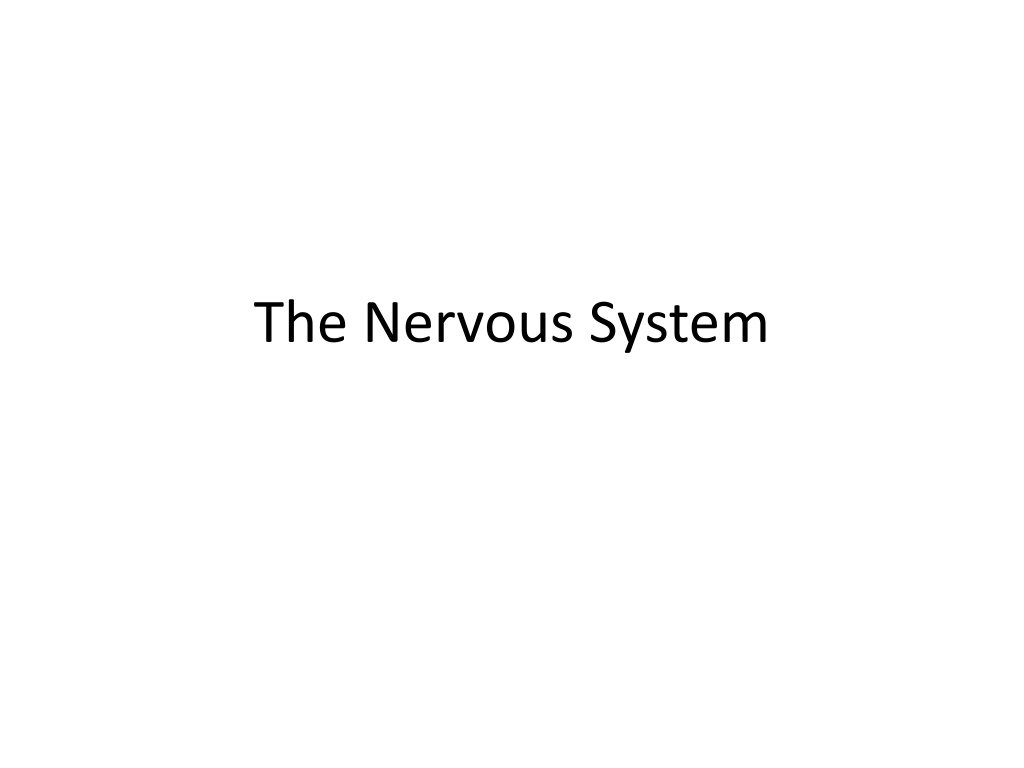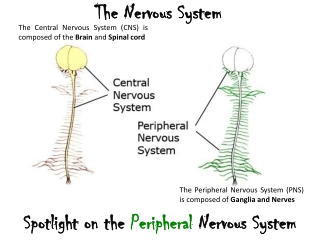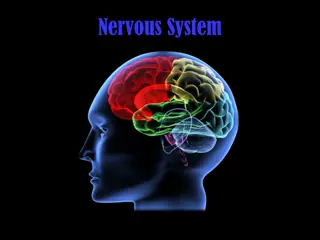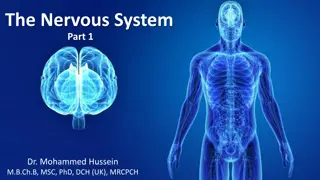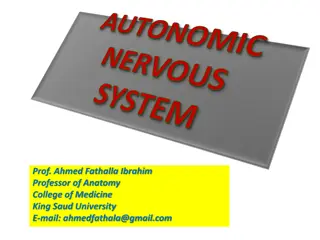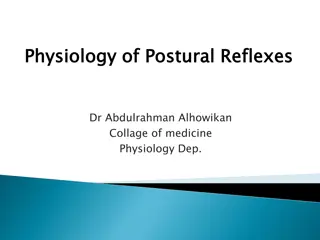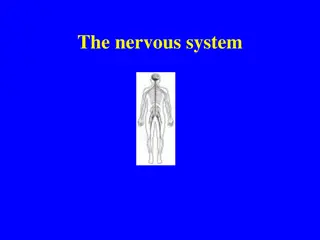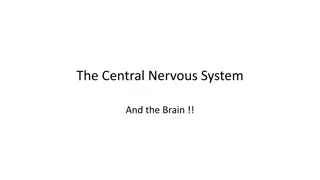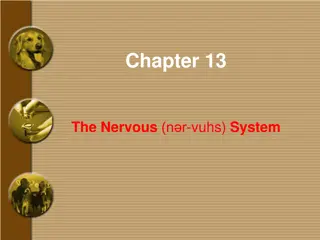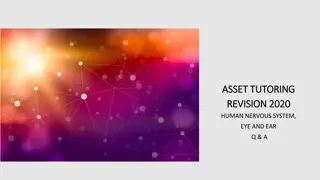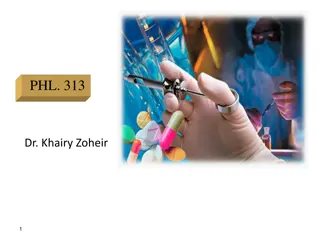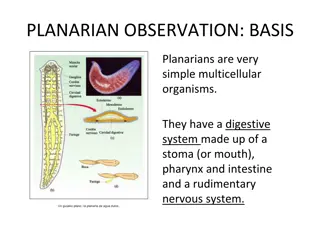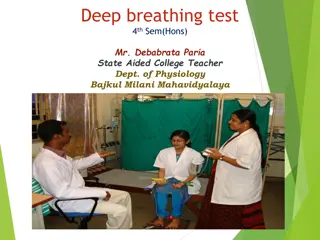Understanding the Nervous System: Structure and Function
The nervous system is a complex network divided into the central nervous system (CNS) and peripheral nervous system (PNS). Neuroglia, or supporting cells, play vital roles in maintaining the health and function of neurons. Neurons, the fundamental units of the nervous system, vary in structure and function. Explore the intricate world of neurons, neuroglia, and the physiological aspects of neuron function.
Uploaded on Sep 18, 2024 | 1 Views
Download Presentation

Please find below an Image/Link to download the presentation.
The content on the website is provided AS IS for your information and personal use only. It may not be sold, licensed, or shared on other websites without obtaining consent from the author. Download presentation by click this link. If you encounter any issues during the download, it is possible that the publisher has removed the file from their server.
E N D
Presentation Transcript
I. General organization of nervous system A. CNS 1. brain 2. spinal cord B. PNS 1. sensory 2. motor a. Somatic b. ANS -sympathetic -parasympathetic
II. Nervous Supporting Cells - neuroglia A. Astrocytes 1. Connect to capillaries 2. Mopping up chemical environment of brain as far as potassium ions and neurotransmitters
B. Microglia 1. spider-like phagocytes 2. debris, dead brain cells, bacteria
C. Ependymal cells 1. lines cavities in CNS 2. beating of cilia moves cerebrospinal fluid 3. fluid nourishes and cushions CNS
D. Oligodendrocytes 1. wrap axons of nerve cells with fatty layer 2. produces myelin sheath 3. speeds conduction
E. Glia cells in general 1. resemble neurons 2. not excitable 3. supportive cells 4. capable of repeated mitosis 5. gliomas-glial tumors
III. Neurons A. Structure 1. cell body 2. nissl bodies-rer 3. dendrites 4. axon 5. axon hillock 6. axon collateral 7. axon terminals 8. neurotransmitters 9. synaptic cleft
B. Myelin sheath 1. functions 2. PNS-Schwann cell 3. Node of Ranvier 4. Can form a pathway for regrowth of damaged axon 5. multiple sclerosis
C. Neurons classified by function 1. afferent 2. interneuron 3. efferent 4. ganglia 5. nuclei
D. Neurons classified by structure 1. multipolar 2. bipolar 3. unipolar
IV. Neuron physiology A. Resting membrane potential B. Action potential-nerve impulse
C. Propagation of action potential 1. diagram on board 2. a lot like dominoes 3. http://www.youtube.com/watch?v=7tBWl4GE8rk&NR=1
D. Anatomy of a synapse 1. presynaptic membrane 2. synaptic cleft 3. postsynaptic membrane 4. synaptic vesicles 5. receptor sites for transmitter substance
E. Physiology of synapse 1. action potential arrives 2. Calcium ion channels open 3. synaptic vesicles fuse with membrane 4. transmitter substance released 5. diffusion of transmitter substance 6. binding to receptors 7. creates a graded potential 8. may bring postsynaptic membrane to threshold 9. nerve gas-blocks cholinesterase
F. You tube of synaptic events http://www.youtube.com/watch?v=z3F5dfmQ 3hk
V. Functional Anatomy of the Brain A. Introduction 1. difficult to talk about 2. two fistfuls of pinkish/gray 3. wrinkled 4. consistency of cold oatmeal 5. three pounds 6. hugely complex 7. four basic regions a. Cerebral hemispheres b. Diencephalon c. Brain stem d. cerebellum
B. Cerebral hemispheres 1. most important part 2. overshadows diencephalon and brain stem 3. mushroom cap covers top of stalk 4. gyri 5. sulci 6. fissures-ie longitudinal cerebral fissure
7. Lobes of cerebrum a. Frontal lobe controls mainly motor function b. Primary motor area is on the precentral gyrus -governs conscious motor control which can be mapped
c. Motor homunculus -specific regions of the precentral gyrus control specific body parts -finer the movements, the more brain area needed to control those movements
d. Premotor area -learned repetitive tasks Typing, playing piano Athletes learn tasks by visualizing motions Ingrained in this area
e. Brocas area speech center Usually located left cerebral hemisphere Damage here causes inability to speak
8. Other important areas of cerebral hemispheres a. Primary somatic sensory area b. Visual area in occipital lobe c. Complex memory in the temporal lobe d. Note close proximity to olfactory area e. Anterior association area-higher intellectual reasoning and socially acceptable behavior
C. Diencephalon 1. Thalamus a. Encloses third vent. b. Screens incoming sensory messages 2. Hypothalamus a. ANS center for body temperature and water balance b. Regulates pituitary 3. Epithalamus a. Pineal gland b. Choroid plexus
D. Brain stem 1. size of thumb 2. midbrain 3. pons 4. medulla 5. interchange for sensory and motor paths 6. nuclei for respiratory, blood pressure, heart rate, RAS
E. Cerebellum 1. Cauliflower shape 2. Controls balance and equilibrium 3. Produces smooth and coordinated muscular contractions
VI. Protection of the brain A. Meninges 1. dura mater 2. arachnoid 3. pia mater B. CSF 1. produced choroid plexi 2. flow 3. functions 4. hydrocephalus
